2012 Fan-Cooled Budget Snowmobiles
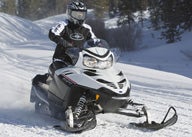
These sleds are light, inexpensive and wicked good fun
For about US$7,000 you can buy some wicked good fun for the trails. Of course, if you choose any of these three trail sport cruisers reviewed here, you’ll need a well-developed ego and strong sense of self as none of the three will give you whiplash when you heavy thumb the throttle lever. What they will give you is more on-trail giggles than you might think is possible. The fun factor is high with any of the three — Arctic Cat’s F570, Polaris’ 550 IQ Shift or Ski-Doo’s MXZ Sport 550F.
If you need to rekindle your love affair with snowmobiling, we seriously suggest spending time aboard one of these fan-cooled 500s. Not so long ago, this was snowmobiling. A 550cc fan-cooled twin was a big deal. Today, not so much as most of us whip on by fan-cooled riders in pursuit of speed and big bump action. That’s not to say that the 2012 breed of fan-cooled powered sleds can’t get you a stern warning from the “trail” police as you see 70-something creep up on the speedometer dial. These sleds will get you into trouble if you don’t pay attention, but fortunately all three sled makers have equipped their “budget” sport models with all the right gear for some incredibly good fun and safe riding.
While none of the three models are what we’d call innovation leaders, they all share the best technologies with their respective high-end models. The Ski-Doo MXZ may be the best of the three when it comes to having the absolute latest chassis as the budget MXZ Sport is based on the newest REV XP platform, which means that it is very light in weight, agile and about as trail capable as the more expensive liquid-cooled versions. The Arctic Cat F570 sits on the Twin Spar chassis, which has been supplanted by Cat’s all-new ProCross design. The Polaris 550 Shift gets the older IQ platform instead of some variation of the newer RUSH chassis.
Power-wise the three fan-cooled engines are surprisingly similar. The Cat’s Suzuki-built twin is the largest, measuring 565cc with a bore of 73.8mm and 66mm stroke. Ski-Doo’s Rotax twin comes in at 533cc and change while the Polaris Fuji-built measures 544cc and features Nicasil cylinder lining for added durability. All three are about 55 to 60 horsepower, which may not sound like much by pure sports standards where the top end sleds range from 155 to 177 peak horsepower.
Interestingly the three fan-cooled models hook up differently between the drive axles and engine’s power takeoff. The 550 IQ Shift is what we’d call the most traditional as it features a proven P85 drive clutch with Polaris’ P2 secondary. Of course, while it’s fairly standard stuff from the Polaris parts bin, the final internal tuning is specifically set for the fan-cooled Fuji’s power characteristics, which is aimed at benefiting the low-end torque criteria of the engine.
Although Arctic Cat is going away from the ACT diamond drive in its newest ProCross and ProClimb chassis models, the F570 retains it, which means you’ll find Arctic’s 6-post rpm-sensing driver and 10.4-inch Arctic roller drive driven. Again the system has been calibrated to take advantage of the Suzuki’s low-end torque for smooth acceleration and good midrange performance. All three drivetrains peter out beyond midrange, but the Cat seems to feel the strongest on long straights.
New for 2012 is Ski-Doo’s addition of the eDrive to its fan-cooled models. Designed to maximize the power output of the four-stroke 600cc ACE introduced last season, the eDrive works extremely well in these “low” horsepower applications. As you know, the eDrive is based on a Can-Am ATV drive system and is both adapted and calibrated for the needs of Ski-Doo’s smaller displacement sleds. Light in weight and efficient for these purposes, the eDrive works in concert with the short shaft version of the QRS driven. The result is a powertrain that operates smoothly but, perhaps, feels a bit lazy when compared to the other more traditional setups. All three drives will result in smooth driveaways, very strong fan-cooled midrange and moderate top end.
The trick to riding any of these sleds fast is learning how much speed to hold onto when heading into a turn and when, if at all, to let off and re-throttle for the turn’s exit. Depending on the trail situation, you very well might find that holding the throttle in and not letting off works quite well. After all, these sleds are so light and maneuverable that you can simply scrub off speed by working the handlebars and kicking the track around a bit. Think in terms of the stock car “bull rings” and not the NASCAR super speedways where you don’t want the rear end stepping out. This is where the fun comes in.
All three sleds come with very good suspensions front and rear. Where the top end models get the best shock packages, these sleds get good but not the best shocks. If you really want to upgrade these funsters for some serious excitement in extremely tight trails, you can add a Walker Evans package to the 550 IQ Shift and better gas-charged shocks to the MXZ. Of the three models, the Arctic Cat needs the most shock help as it comes with hydraulic tube shocks all around. The Motion Control shocks on the Ski-Doo MXZ will resist fade for a while but you might seriously want to think about opting in for the HPG gas shocks that come on the TNT series. If you don’t ride hard, no need to upgrade. But if you like to hit the twisties with aggressive riding, you may find the base shocks heat quickly and when they fade they will have your front end dipping like an old guy’s jeans.
These sleds are great fun and much of that comes from the simple fact that without all that requisite plumbing to accommodate liquid-cooling, the front ends are exceptionally lighter. All three are a blast to ride quickly. All are very maneuverable. All grip the trail very well, although you might find the front end too light and steering too easy until you get used to it. They are truly that light.
All of the two-strokers come with a version of pushbutton reverse, which makes everyday life on the trail so much nicer. Only the Arctic Cat and Ski-Doo come with hooked handlebar ends, but they are an available option on the Polaris. Of course, even with the standard J-hooks off the steel bar set, the Ski-Doo cannot match the ergonomic handlebar of the Cat. This is the same as you’d get on the top Cat sport sleds and it’s outstanding.
The base price of the Arctic Cat F570 will be higher than the other two, but that has a lot to do with Cat including electric start as standard equipment. Add that option to the Ski-Doo and it bumps the price another US$400.
All in all, we find that any of the three fan-cooled 550s will provide you with an incredible ride back into why you love snowmobiling in the first place. If you’ve ever thought about getting into vintage snowmobiling but have backed off because you don’t like to fiddle with sleds, then maybe one of these “throwback” fan-cooled sleds could give you some of that experience. Of course, you’d be missing out on the vintage three-inch rear suspensions and lack of ergonomics. And, with a new fan-cooled sled like one of these, you’d have long travel ride, a warranty, pushbutton reverse, electric start option and virtually no maintenance. These are great rides for the money that give you a relaxed taste of the sport.
| 2012 Arctic Cat F570 | 2012 Polaris 550 IQ Shift | 2012 Ski-Doo MXZ Sport 550F | |
| Engine | Suzuki 565cc twin cylinder 2-strokel fan-cooled, two 34mm VM Mikuni carbs | Polaris 544cc twin cylinder 2-stroke; fan-cooled; two VM34 carbs | Rotax 553.4cc fan-cooled two-stroke twin; two VM30 carbs |
| Horsepower | 55-plus | 55-plus | 55-plus |
| Drive | Arctic 6 post rpm sensing with 10.4-in diameter Arctic roller cam secondary; electronic push button reverse | Polaris P-85 drive; P2 driven with PERC electronic push button reverse | eDrive primary with QRS secondary; electronic reverse |
| Front Suspension | AWS 7 double A-arm; hydraulic shocks, sway bar, up to 9.5-inches of travel | Polaris IQ — 10-in maximum travel; RydeFX MPV shocks | Dual A-arm; Motion Control shocks; 9.0 inches of travel |
| Rear Suspension | Arctic Cat FasTrack slide action with coupling blocks; hydraulic twin tube shocks; up to 13.5-in of travel | Polaris IQ parallel rail; 13.9-inches of travel; RydeFX MPV shocks | SC-5 parallel rail with Motion Control shocks; up to 15.0 inches of travel |
| Length | 118.0 in | 115.0 in | 114.4 in |
| Width | 48.0 in | 48.0 in | 47.9 in |
| Height | N/A | 45.0 in | 47.6 in |
| Ski Stance | 43.0 in | 42.5 in | 42.4 in |
| Track | 15 x 128 x 1.0 | 15 x 121 x 0.91 Shockwave | 15 x 120 x 1.25 RipSaw |
| Weight | N/A | 470 lb (claimed) | 423 lb (claimed) |
| Brake | Hydraulic disc with disc on drive shaft | Polaris Phantom hydraulic | Brembo hydraulic |
| Features | Electric gas gauge; electric start Options: storage bags; rearview mirrors; accessory outlet; windshields |
Options: 12v-DC outlet; handlebar hooks, bags, mirrors, electric start | Standard: straight steel bar with J-hooks; Tach, speedometer, fuel gauge Options: mirrors, electric start, hitch |
| Fuel Capacity | 10.8 US Gal (91 octane fuel) | 11.5 US Gal | 10.6 US Gal |
| MSRP | $7,199 | $6,399 | $6,899 |
| Full Specs | Here | Here | Here |
Related Reading
2011 Fan-Cooled 550cc Trail Sportsters
2010 Arctic Cat F570 vs. Polaris 550 Shift IQ vs. Ski-Doo MXZ TNT 550F
2010 Polaris 550 IQ Shift Review
2009 Arctic Cat F570 Review



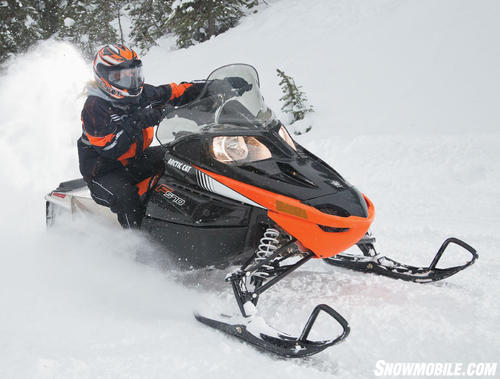
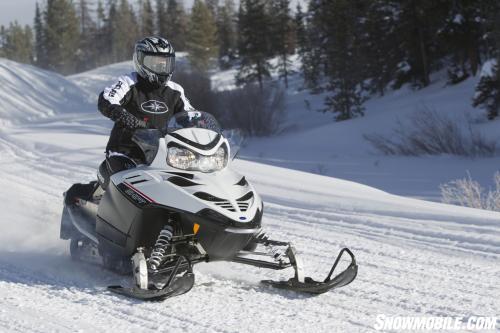
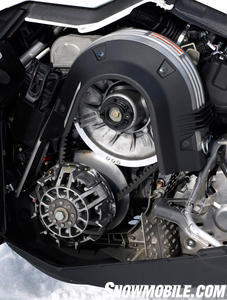
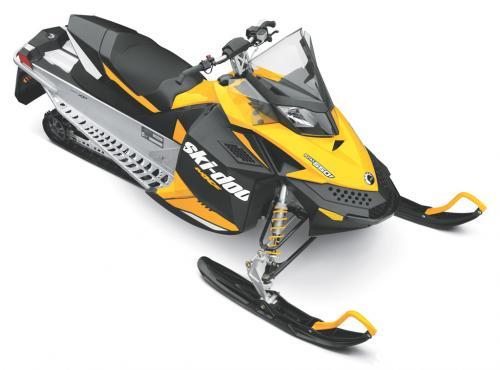
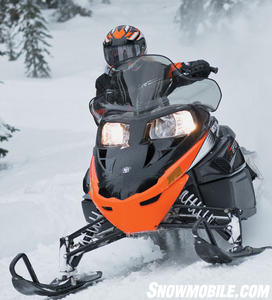
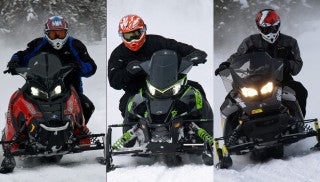
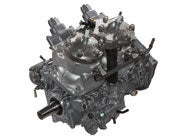
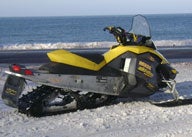


 Your Privacy Choices
Your Privacy Choices